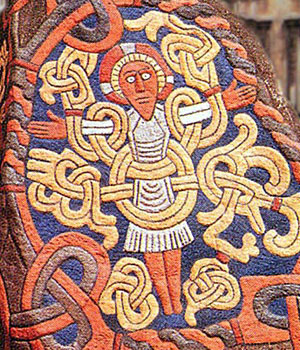| Centralmagten

| | Opbygning af en stærk centralmagt gjorde det nødvendigt at kongemagten arbejdede nært sammen med kirken.
Denne alliance grundlægges tidligt, hvilket Harald Blåtands tekst på Den store Jellingesten vidner om: (Han) vandt sig alt Danmark og Norge og kristnede danerne.
Op gennem middelalderen var forholdet mellem kongemagt og kirke dog ofte præget af modsætninger. |
Opbygningen af en stabil centralmagt i den tidligste middelalder hviler på et tæt samarbejde imellem kirke- og kongemagt. Temaet slås an allerede på den berømte Store Jellingesten, hvor vi får at vide, at Harald Blåtand, der døde omkring 985, "Vandt sig alt Danmark og Norge og kristnede danerne".

Jellingestenene |
Borge og mønter
Etableringen af en vis centralmagt omkring dette tidspunkt bekræftes bl.a. af anlæggelsen af større militære anlæg som f.eks. Trelleborg på Vestsjælland, og tilsvarende ved Trelleborg i det sydøstlige Skåne.
Borganlæggene er antagelig kaserner, som måske er de knyttet til de oversøiske erobringstogter, der fortsætter ind i 1000-tallet, eller de kan være opført med henblik på lokalt forsvar. Under alle omstændigheder vidner det om en korrdineret indsats omkring militærvæsenet, og om centralmagtens underlæggelse og beherskelse af forskellige områder i riget.
Møntudstedelse er et andet tidligt vidnesbyrd om overordnet beherskelse af et område. I 1000-tallet begynder kongemagten at slå mønt bl.a. i Lund.

Kongens mønt | 
Knuds mønt | 
Knud den Hellige |
Kristendommens indførelse
Det er nok en tilsnigelse, når Harald Blåtand hævder at danerne blev kristnet før årtusindskiftet, men at kongemagten stræber efter at indføre og rodfæste kristendommen og dermed også styrke kongedømmets position vidner lidt senere tiltag om. I 1027 rejser Knud den Store(1018-1035) således til Rom, hvor han påskedag i Peterskirken overværer indsættelsen af en ny tysk-romersk kejser, formelt giver sig ind under denne, og selv fremstår som den store kristne fyrste fra Norden.
Rigets grænser
Stadigvæk er der dog tale om en brydningstid, hvor kristendommen endnu ikke er rodfæstet i samfundet og rigssamlingen fortsat pågår. Grænsen imellem Sverige og Danmark fastlægges først omkring 1070, hvor der opsættes seks grænsestene, heraf de fem på grænsen imellem Halland og Sverige og kun en enkelt på tværs i det nordlige Blekinge. Småland henligger endnu som en naturlig grænse af uigennemtrængelig skov.

Grænsesten |
Første beskrivelse af Norden
Omtrent på samme tidspunkt, altså omkring 1070, forfatter Adam af Bremen den første beskrivelse af Norden i værket De hamburgske Ærkebispers Historie. Interessen er at skildre Norden som ærkebispesædets missionsmark, men vi får tillige den første topografiske og historiske beskrivelse af Norden, som bygger på både skriftlige og mundtlige kilder, heriblandt udsagn fra den danske konge, Svend Estridsen(1047-1076).
Adam af Bremen fortæller i værket om Jylland, at det "er næsten ikke opdyrket nogetsteds og heller ikke egnet til menneskelig beboelse..." ,det"... er langt den mest grufulde landsdel, og man undgår gerne området: til lands på grund af mangel på korn, til vands på grund af faren for sørøvere."
Om Sjælland hedder det bl.a.: "Øen Sjælland, der ligger i det indre af Det baltiske Hav, er vældig af omfang. Sjælland, som er berømt for sine indbyggeres tapperhed og rige afgrøde, er to dagsrejser lang og næsten tilsvarende bred. Den største by er Roskilde -Danmarks kongesæde".
Tyngdepunkt i øst
Adam af Bremens beskrivelse kunne tyde på at tyngdepunktet i riget i anden halvdel af 1000-talllet er flyttet fra Østjylland til Sjælland, -måske på grund af de bedre produktionsbetingelser for landbruget i den østlige del af landet. Om Skåne hedder det, at det er "Danmarks skønneste landsdel, hvoraf den har fået sit navn. Den er svært væbnet med mænd, frugtbar på korn og handelsvarer" Hertil føjer han at Skåne også er fyldt med kirker, dobbelt så mange som på Sjælland, dvs. 300, men at Skåne endnu ikke har en biskop.
De første biskopper
Andre kilder beretter imidlertid, at der allerede i 1030 udnævnes en biskop over Sjælland, som også har myndighed over Skåne. Ved midten af 1000-tallet residerer der en biskop i Lund, men også i det nærliggende Dalby oprettes der omkring dette tidspunkt et bispesæde, som omfattede Østskåne, Blekinge og Bornholm.
Kongemagten knytter sig tilsyneladende tæt til bispesædet i Dalby idet Svend Estridsen(1047-74), som arbejder for oprettelsen af et særskilt ærkebispedømme i Norden, her lader opføre en kongsgård og en stenkirke, formodentlig Nordens ældste. Fra Dalby stammer formodentlig også den ældste kendte bog, der er udført i Norden, evangelieskriftet Dalbybogen.

Dalby kirke, Skåne | 
Basilika | 
Portalen | 
Krypten | 
Døbefonten |

Biskop Egino | 
Dalbybogen | 
Svend Estridsen |
Engelsk og tysk påvirkning
Den ornamentale stil i håndskriftet fra Dalby tyder på påvirkning fra det engelske område. Påvirkning fra den anden side af Nordsøen kan også påvises i kirkebyggeriet, f.eks. i Vejby kirke i Nordsjælland og giver anledning til spekulationer om rivalisering imellem angelsaksisk og nordtysk mission i Danmark.
Da biskoppen i Lund, Henrik, dør efter 1060 flytter Dalby-biskoppen Egino, der har tilknytning til ærkebispesædet i Hamburg-Bremen, til Lund og bliver biskop over Skånelandene, dvs. Skåne, Halland, Blekinge og Bornholm. I 1072 udnævner Svend Estridsen tyskeren Rickwald til biskop Lund. Selvom Rickwald var bandlyst og udstødt af kirken i Nordtyskland sidder han i 17 år uforstyrret på bispesædet i Lund. Det fortæller noget om, hvor løs forbindelsen til pavekirken endnu er. |